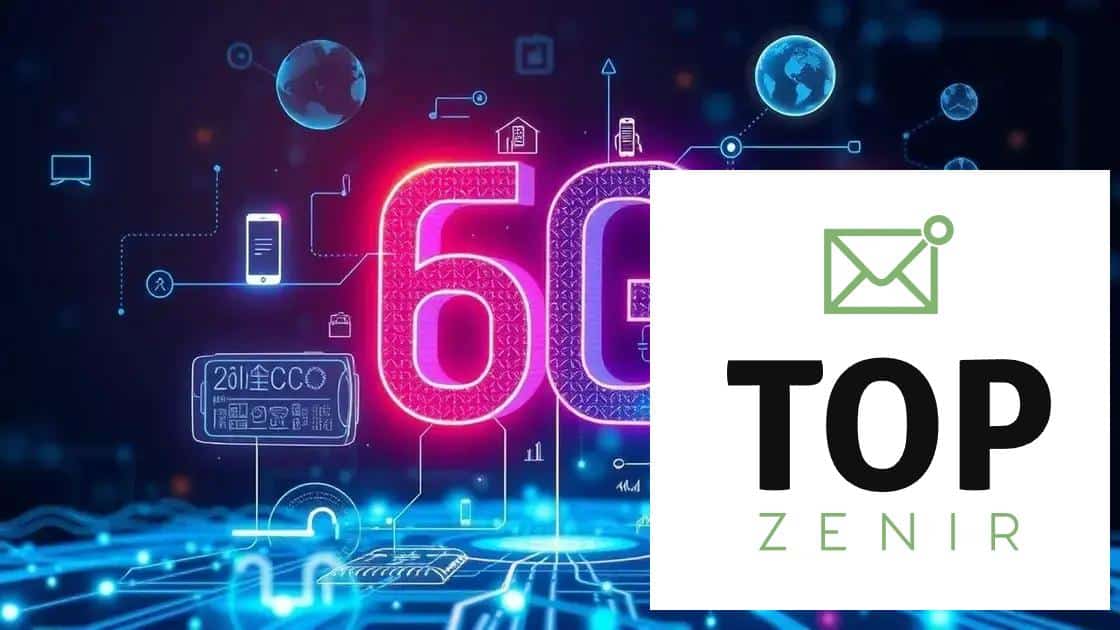6G networks begin deployment trials in key markets

6G networks are the next generation of mobile communication, offering ultra-fast speeds, low latency, and new applications that will transform smart cities, healthcare, and entertainment experiences.
6G networks begin deployment trials in key markets, setting the stage for a revolutionary leap in connectivity. But what does this really mean for our daily lives? Let’s dive into the implications.
What are 6G networks?
6G networks are the next evolution in mobile communication technology, following the current 5G networks. These networks promise to deliver even faster speeds, lower latency, and enhanced connectivity. Imagine a world where everything is connected, from smart homes to autonomous vehicles. That’s the vision behind 6G.
Key characteristics of 6G networks
One of the main features of 6G technology is its ability to support vast amounts of data transfer at unprecedented speeds. It aims to achieve speeds of 100 times more than 5G, which translates to download times that are virtually instantaneous.
- Speed: Expected to exceed 1 terabit per second.
- Latency: Targeting latency as low as 1 microsecond.
- Capacity: Enhanced capacity for connections, accommodating more devices.
- Applications: New applications like holographic communication and real-time AI interactions.
Furthermore, 6G networks are designed to be more energy-efficient. This means that not only will they provide faster services, but they will also do so in a way that is sustainable and environmentally friendly. Researchers are exploring innovative technologies such as terahertz waves, which may be key to unlocking these advancements.
Global collaboration and deployment
As nations and companies begin to outline their 6G development strategies, international collaboration is becoming increasingly important. Countries around the world are investing in research and infrastructure to ensure a smooth transition to 6G. This collaborative effort will likely lead to innovations in technology and telecommunications.
Moreover, the deployment of 6G is expected to create new opportunities in various sectors, including healthcare, education, and entertainment. By integrating advanced technologies, 6G has the potential to revolutionize industries, making our lives more interconnected than ever before.
Key features of 6G technology

6G technology is set to revolutionize the way we connect and communicate. Building on the foundation of current networks, it introduces exciting new features that promise to enhance our daily lives. Understanding these key features is essential as we move toward this next-generation technology.
Enhanced Speed and Performance
One of the standout characteristics of 6G networks is the incredible speed they are expected to deliver. We are talking about potential speeds reaching up to 1 terabit per second. This leap in performance will enable a wide range of applications, from streaming ultra-high-definition content to facilitating smooth virtual reality experiences.
- Ultra-fast downloads: Imagine downloading an entire movie in just seconds.
- Real-time communication: Expect virtually no lag in video calls or online gaming.
- Seamless connectivity: More devices can connect without affecting performance.
Additionally, 6G technology aims to achieve extremely low latency, reducing communication delays to under 1 millisecond. This is crucial for applications that require real-time feedback, such as remote surgery and autonomous driving.
Smart Device Integration
As we embrace a world filled with smart devices, 6G networks will play a significant role in integrating these technologies. From home appliances to wearables, the connectivity provided by 6G will ensure that these devices can communicate effortlessly. This will lead to smarter homes and cities, where systems work together harmoniously.
Additionally, the technology is designed to support a massive number of devices per square kilometer, enabling the Internet of Things (IoT) to thrive. The future will see a seamless exchange of information between devices, enhancing efficiency and user experience in everyday life.
Energy Efficiency
Another vital aspect of 6G technology is its focus on sustainability. The networks will be designed to be more energy-efficient, helping to reduce the carbon footprint of digital communication. By utilizing advanced technologies and smarter designs, 6G aims to deliver high performance while supporting environmentally responsible practices.
With innovations like smart energy management systems embedded in the networks, we can expect to see a significant reduction in power consumption without compromising on speed or reliability.
Deployment trials in major markets
Deployment trials of 6G networks are currently taking place in major markets around the world. These trials are crucial in testing how well this new technology will perform in different environments and conditions. By experimenting in various locations, companies can identify potential challenges and optimize the networks before full-scale deployment.
Global Initiatives
Several countries are taking the lead in 6G trials, aiming to become the first to roll out this advanced technology. For instance, nations like the United States, South Korea, and Japan have launched initiatives that focus on innovation in telecommunications. Collaborating with academic institutions and tech companies, they are laying the groundwork for future networks.
- United States: Major telecom companies are conducting tests that focus on network reliability and speed.
- South Korea: Known for its advancements in technology, South Korea plans to implement real-world trials in urban settings.
- Japan: Japan is focusing on integration with smart city infrastructure, enhancing urban living.
Through these efforts, each market is gathering valuable data on user experiences and technical performance. This information helps in shaping the future of 6G and understanding how it can benefit everyday tasks.
Testing in Different Environments
Another important aspect of deployment trials is testing the networks in various environments, from rural to urban areas. Different settings present unique challenges, and addressing these is key to ensuring the technology’s success.
For example, urban areas may have high demand and more devices connected, while rural regions may struggle with coverage. The trials focus on ensuring that 6G technology performs optimally across these diverse scenarios. The insights gained will help in perfecting network design and deployment strategies.
With strategies in place for extensive global testing, the industry aims to roll out effective and reliable 6G networks. The adoption of this technology could dramatically change how we live, work, and connect.
Impact on everyday users
The impact of 6G technology on everyday users is expected to be profound and transformative. As this new network begins to roll out, it will enhance how we interact with the digital world around us. Users will experience faster and more reliable connections, changing the way we browse, work, and communicate.
Enhanced User Experience
With the deployment of 6G networks, everyday tasks will become more efficient. For instance, streaming high-definition videos will become seamless, without buffering interruptions. Online gaming will feel more immersive, as low latency will allow for instant reactions and smoother gameplay.
- Real-time collaboration: Working remotely will be enhanced by sharper video calls and quicker file sharing.
- Smart home integration: Devices will communicate faster, making homes more responsive to user needs.
- Transportation innovation: Self-driving cars will benefit from improved communication with traffic systems.
In addition, 6G networks will facilitate advancements in augmented and virtual reality experiences. Users will find themselves in fully immersive environments that blend seamlessly with reality. Whether for gaming, training, or education, the opportunities are limitless.
Accessibility and Connectivity
6G technology aims to bridge the digital divide by improving connectivity in both urban and rural areas. By focusing on making technology accessible to all, everyday users will benefit from broader internet coverage. Students in remote areas will gain access to digital learning resources that were previously unavailable.
This enhanced connectivity will also support telehealth services, allowing patients in underserved areas to receive quality healthcare remotely. The ability to connect with doctors and specialists from the comfort of home can greatly improve health outcomes.
Moreover, businesses will find new ways to engage with customers through more personalized experiences powered by advanced data analytics. All these advancements signal a bright future for users in various segments of society, improving daily life significantly.
Future applications of 6G
The future applications of 6G technology promise to go beyond anything we currently imagine. As we anticipate its rollout, many new possibilities are emerging that could redefine various sectors and transform our daily lives.
Smart Cities
One of the most exciting prospects is the development of fully connected smart cities. These spaces will utilize 6G networks to integrate systems for transportation, energy management, and public safety. With real-time data sharing, city management will become more efficient, leading to improved quality of life for residents.
- Traffic control: Smart traffic lights will adjust based on real-time conditions.
- Public safety: Enhanced surveillance systems can improve response times.
- Energy savings: Smart grids will optimize energy usage across the city.
As cities become smarter, citizens will enjoy not only convenience but also increased safety and sustainability.
Healthcare Innovations
In healthcare, 6G networks will facilitate new telemedicine solutions. Doctors will be able to perform remote surgeries with precision due to ultra-low latency. Patients can access healthcare services from anywhere, making medical assistance universally accessible.
Furthermore, with vast amounts of data being transmitted quickly, advanced AI algorithms can analyze health trends and predict outbreaks, enhancing public health responses.
Immersive Experiences
The entertainment sector is also set for a major overhaul. Imagine fully immersive virtual reality (VR) experiences that feel as real as being present physically. 6G technology will enable high-quality VR and augmented reality (AR) experiences for gaming, education, and training sessions.
These applications will not only transform entertainment but will also provide new ways for users to engage with content, making learning and training more effective.
In addition to these, industries like agriculture will leverage 6G technology for precision farming, enhancing crop yields through real-time data analysis and smart farming equipment. As these applications unfold, their potential to change how we live and work will be truly remarkable.
In conclusion, the rollout of 6G technology is poised to transform our lives in exciting ways. With its ultra-fast speeds and low latency, we can expect smarter cities, revolutionary advancements in healthcare, and immersive entertainment experiences. These innovations will not only improve daily life but also create new opportunities across various sectors. As we stand on the brink of this technological shift, it’s clear that 6G networks will significantly impact how we connect, work, and interact in the future.
FAQ – Frequently Asked Questions about 6G Technology
What are the main benefits of 6G technology?
6G technology offers ultra-fast speeds, low latency, and improved connectivity, enhancing user experiences in various sectors.
How will 6G impact healthcare?
6G will enable advanced telemedicine solutions, allowing for remote surgeries and better access to healthcare services.
What role will 6G play in smart cities?
6G will improve efficiencies in city management, enabling smart traffic systems and better public safety measures.
When is 6G expected to be widely available?
While deployment trials are currently underway, widespread availability of 6G is anticipated in the late 2020s.





